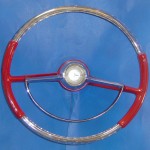Where is the best place to send my steering wheel for a repair?
Thanks
Thanks
Thank you for visiting the SDC Forum, a service of the Studebaker Drivers Club, Inc., an International non-profit organization dedicated to the promotion and preservation of Studebaker automobiles.
Our Forum is free to use, but in order to join the discussion boards you will first need to register.
Read our Policies and Terms Of Service here.




 (I'm certainly not getting paid for this commercial)
(I'm certainly not getting paid for this commercial)

Comment